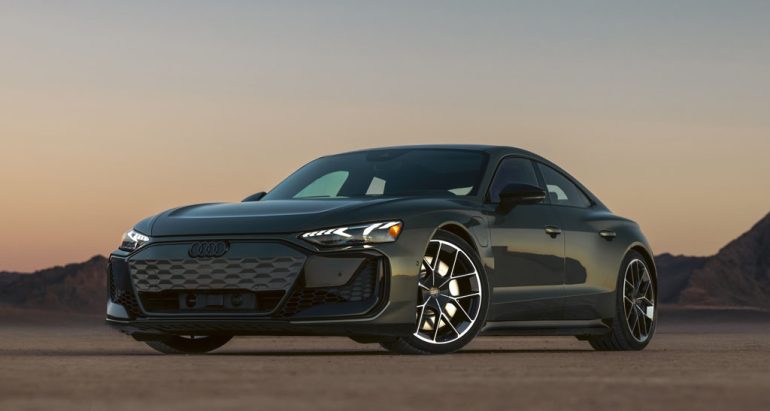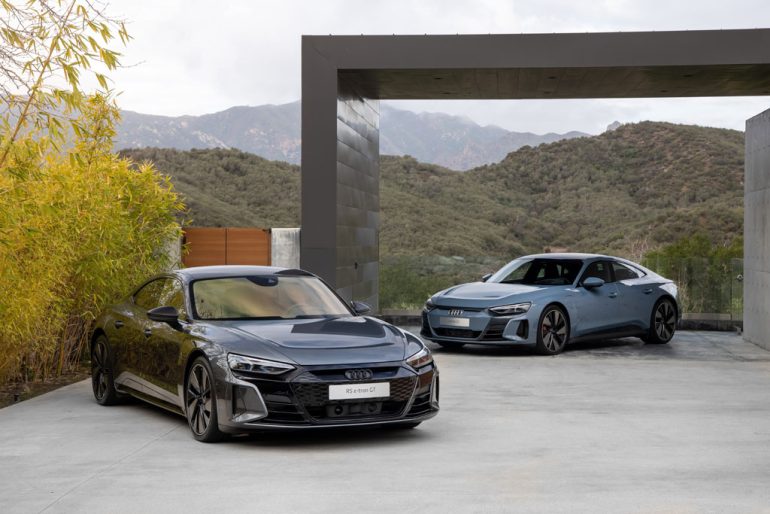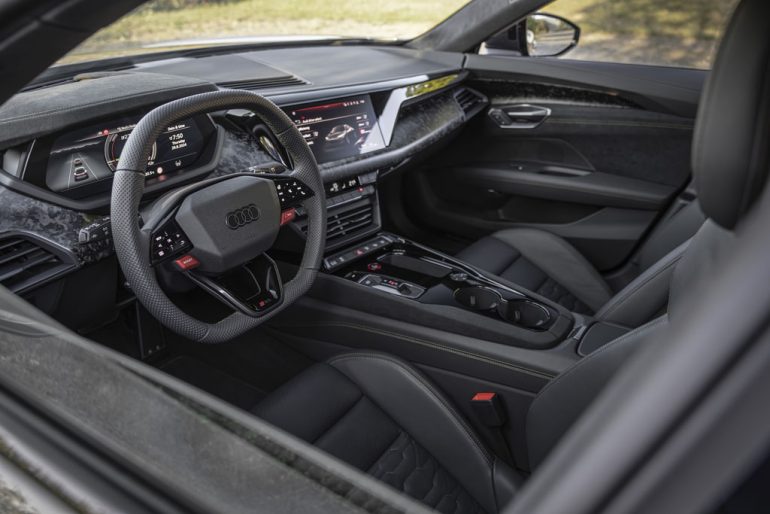
Experienced by Kimatni D. Rawlins, www.AutomotiveRhythms.com
There’s a quiet storm combusting in the Nevada desert, creating a mystical weather phenomenon. The electrical storm is ignited by a 105 kWh lithium-ion battery (800v), torque vectoring quattro AWD, and a dual-motor powertrain that generates 912 German steeds, translating to a 0-60 mph strike in just 2.4 seconds with launch control engaged. Thus, the 2025 Audi RS e-tron GT performance is the most potent production and quickest accelerating Audi ever.
That’s right—Audi’s fastest vehicle in history is a four-door EV coupe! Sharing the same platform as the Porsche Taycan (distinguishable tuning), the latest e-tron supercar is long, low, and wide. Additional performance parameters stem from 6-piston front calipers, 16.1″ ventilated front rotors, optional 21″ 6-double-spoke RS design rims, a new active suspension that lifts for entry and exit, all-wheel steering, a larger rear diffuser, Push-To-Pass mode, and Launch Control. Trust me, you will immediately feel the wrath of its power upon acceleration.

I joined Audi in Las Vegas to experience the RS e-tron GT performance and all of its technical wonders. We first drove the GT on the spiral roads outside Red Rock Canyon National Park, then hit SPEEDVEGAS located 15 minutes from the Las Vegas Strip for acceleration runs and cornering capabilities on the 1.3-mile, 10-turn road course that features Formula One safety barriers. EXOTICS RACING hosts daily supercar experiences here for Speed Racers who wish to challenge their skill sets. But in this case, Audi gave us a gift in the form of Stephan Reil, Chief Technical Engineer of the e-tron GT. He flew in from Germany to guide the attending media through the engineering techniques and to demonstrate the latest innovations of the vehicle.

For 2025, the e-tron GT family highlights two models: the S e-tron GT and RS e-tron GT performance, which we had access to. The flagship electric e-tron GT first launched in 2021 and is now in its fourth model year. With a top speed of 155 mph, the RS e-tron GT performance was tenacious, undeterred, and resolute on the track. Technical proficiency in the battery achieved a 12% increase in capacity over the previous 93.4 kWh battery, while weight decreased by 25 pounds. DC fast charging capability has also increased from 270 kW to 320 kW, resulting in a 10-80% charge time in about 18 minutes.

Located on the left side of the motorsports-inspired flat-top and flat-bottom steering wheel, the most exciting superpower of the RS e-tron GT performance is the Push-To-Pass boost mode, similar to my Eagles’ unstoppable Tush Push play. It puts an additional 94-horsepower (70kW) at your disposal for increased and unadulterated acceleration for up to 10 blistering seconds. Afterwards, the EV requires another 10 seconds to reset.

The difference between EV speed and gas-powered takeoffs is the lack of rumbling to prepare you for the acceleration, except for the e-tron’s sport digital sound effects akin to the Millennium Falcon from Star Wars. The RS e-tron GT performance travels at the speed of light without any traditional exhaust note warning, so its power catches you by surprise. In this mode I reached 140 mph with ease while wailing the entire time. The vehicle stayed planted at high speeds while the active suspension helped the RS remain leveled by counterbalancing weight and body roll against the driving surface. Moreover, a new RS performance mode has been integrated into Audi drive select (Efficiency, Comfort, and Dynamic modes) to allow for the most capable version of itself on race circuits. Lastly, owners can program the configurable RS-specific RS1 and RS2 modes to their individual drive styles.

Aesthetically, the EV GT receives new front and rear fascias and four fresh and energetic hues such as Progressive Red, Arkona White, or my favorite, Bedford Green. Like all premium Audis, the cockpit is intelligent, sporty, and professional. A key upgrade is the $8,400 Forged Carbon package lining the outside componentry and specific cabin inlays. However, I am not a fan of the pattern whatsoever and prefer the woven carbon look. The most extraordinary feature may be the panoramic glass roof with transparency control utilizing nine tones thanks to its liquid crystal film. If that’s too much, then flow with the carbon fiber roof.

Of course, the world is facing a global warming crisis that requires the reduction of humankind’s carbon footprint. With that, every major automaker is tooling with the production of EVs. Some brands build only EVs like Rivian and Lucid. Audi continues to view the future with a focus on electric vehicles and believes its strategic dual approach, ICE and EV-specific architectures, will help with consumer adoption. The German automaker persists in moving toward being carbon neutral by 2050.

With an expected range of 278 miles, the omnipotent 2025 Audi RS e-tron GT performance is yours for a starting MSRP of $167,000, excluding the $1,295 destination fee. Another $11,000 upgrades you to the Dynamic Plus package, which features the active suspension, carbon ceramic brakes with red or gray caliper options, and high-performance Goodyear Eagle F1 summer tires. My daylong reservation with the RS e-tron GT performance was purifying, unique, and fulfilling. Are you ready for a mobility shift towards electric high-performance through Audi innovation? Decisions, decisions, decisions!
FOLLOW US TODAY:

